Assassination Attempt on Prince Alfred
This article by Guest Blogger Diane Oldman was first published here on 19 Sept 2013.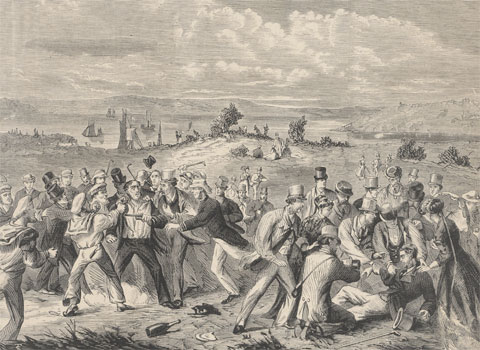
In March 1868, a mentally disturbed Irish-born Australian shot and wounded Prince Alfred, Duke of Edinburgh, at a picnic on Sydney harbour. The would-be assassin, Henry James O'Farrell, falsely claimed to be a Fenian and his shots resounded around Australia as a torrent of violent and irrational anti-Irish hatred spread through a colony already tense and nervous about reports of terrorism in England. O'Farrell was convicted and sentenced to death.
Prince Alfred himself tried unsuccessfully to intercede and save his would-be killer's life.
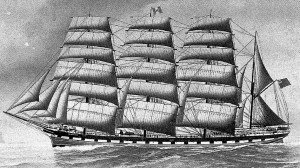 Two months earlier, 62 Fenian convicts had arrived in Western Australia on the Hougoumont, the last convict ship to Australia, which arrived in Fremantle on 9 Jan 1868.
Two months earlier, 62 Fenian convicts had arrived in Western Australia on the Hougoumont, the last convict ship to Australia, which arrived in Fremantle on 9 Jan 1868.
Then in 1876 an incident concerning the Fenian convicts led to a piece of Rockinghams history every bit as exciting as the outlaw Ned Kelly's story; I am referring, of course to the Catalpa escape.
For those of us who do not have Irish ancestry, the troubles that pitted Irishman and Englishman against each other have at best passed us by or at worst left us with a one dimensional view. Nonetheless, those who view the Fenians as traitors need to know that some had also been heroes fighting for the British Army.
Seventeen of the Hougoumont Fenians had been court martialled in Ireland in 1867/68.
I was seeking Crimean War Veterans and, in the absence of WO97 discharge to pension documents, found one of them on the medal rolls for that campaign. The remaining soldiers-cum-Fenians were either too young to have served in the Crimean War (e.g. John Boyle O'Reilly) or were in regiments not engaged in the conflict. Most of the 17 were charged with mutinous conduct or not informing about a mutiny. Ten of them were imprisoned in Ireland and England in the same prison recording consecutive prison numbers, and the Catalpa incident shows that six out of the 17 escaped on the American whaler.
The 17 Fenians court martialled: Robert Cranston, Thomas Darrah, Thomas Delaney, John Donaghoe, John Foley, William Foley, Michael Harrington, Thomas Hassett, Martin Hogan, Patrick Keating, James Keilly, Patrick Killeen, John Lynch, James McCoy, John Boyle O'Reilly, John Shine, James Wilson.The ten men in prison together: Delaney, Donaghoe, William Foley, Hassett, Hogan, Keating, Lynch, McCoy, Shine and Wilson.
The six men who escaped on the Catalpa: Cranston, Darragh, Harrington, Hassett, Hogan and Wilson.
British Crimea Medal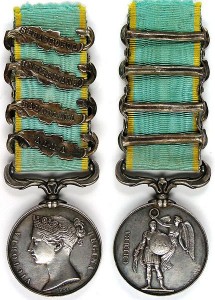 Turkish Crimea Medal
Turkish Crimea Medal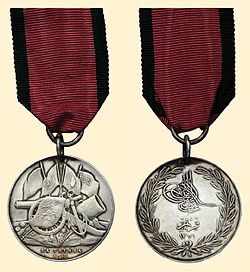
Crimean Medal (three Clasps) (WO100-24) & Turkish Medal awarded Patrick Keating 5th Dragoon Guards.Keating took part in the successful Charge of the Heavy Brigade under General Scarlett at Balaclava and received clasps for Balaclava, Inkerman and Sevastopol. He was sentenced to life for mutinous conduct at his Dublin trial in 1866. After his time in Fremantle prison, he got his Ticket of Leave in July 1873. Less than a year later he died of an aneurism.
Punjab Medal 1848-49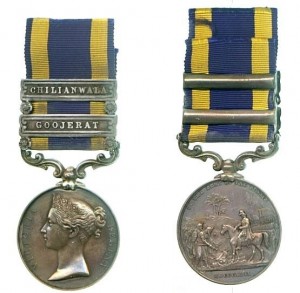 Indian Mutiny Medal 1857-58
Indian Mutiny Medal 1857-58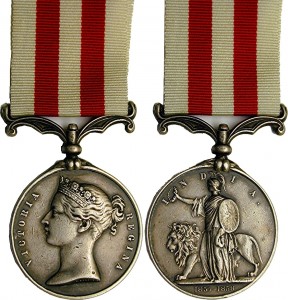 China Medal 1860
China Medal 1860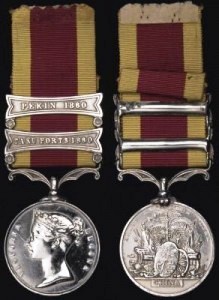
Punjab Medal 1848-9 & Indian Mutiny Medal 1857-8 (WO100-38) awarded to Michael Harrington 61st Regiment of Foot who fought in both these conflicts. He received clasps for Chilianwala and Goojerat in the last campaign against the Sikhs. Harrington was born in Goleen, Cork in 1826 and joined the Fenian brotherhood in 1864. He received a life sentence for mutinous conduct and desertion. He was one of the six Fenians in Fremantle Prison who made their escape on the Catalpa. Harrington settled in New York and died there of pneumonia in February 1886 aged 60.
Second China War Medal (2nd Opium War) with clasps for the capture of the Taku Forts and Pekin in 1860, awarded to Thomas Darragh 1st Battalion of the 2nd Regiment of Foot and John Shine 2nd Battalion of the 60th Royal Rifles. Both men were convicted of mutinous conduct at courts martial in 1866. Darragh made his escape on the Catalpa and settled in Philadelphia.
John Shine was granted his conditional pardon in 1878. He worked around Champion Bay, Perth, Swan, Wellington, York and Beverley as a labourer, general servant, shepherd and reaper. He left WA for Victoria in 1882.The Catalpa Rescue (courtesy of National Museum of Australia)
In 1874, Irishman John Devoy, living in the United States, must have been astonished to receive a letter from a British convict serving a life sentence in Western Australia.
The writer James Wilson wrote that his was a "voice from the tomb ... For is not this a living tomb". Wilson was one 12 Irish political prisoners, members of an Irish republican organisation called the Fenians, still serving long sentences as British soldiers for mutinous conduct. Altogether 62 Fenians, convicted of crimes ranging from treason-felony to outright rebellion, had been transported to Western Australia in 1868 on the last Australian convict ship, the Hougemount. By 1874, all had been released except the so-called military Fenians, men such as Wilson. They thought the British would leave them to rot in prison to make an example to others for their double treachery to country and uniform.
Devoy responded quickly to this terrible appeal. One of the key Fenian leaders in America, he organised the purchase of an American whaling ship, the Catalpa, in New Bedford, Massachusetts, and for the ship to sail to Western Australia to rescue his Fenian brothers from their British prison in Fremantle. As leader of the expedition, and captain of the Catalpa, Devoy chose George Smith Anthony, an American with no Irish connections. Anthony felt sorry for the Fenians, men he thought were being persecuted for love of country. Two Fenian agents, John Breslin and Thomas Desmond, were sent to Western Australia, to organise the rescue on the ground.Contact was made with six Fenian prisoners capable of making the break and on 17 April, Easter Monday and Perth Regatta Day, Breslin and Desmond drove the six prisoners at a furious pace in horse-traps 20 miles south of Fremantle to Rockingham pier where Anthony was waiting for them with one of the Catalpa's whale boats.
'Escape of Fenian convicts from West Australia' 1876 - Australian National Maritime Museum
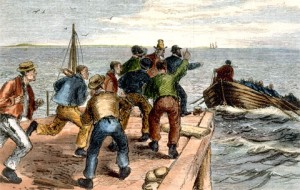 The escape was soon discovered by which time the whaleboat was on its way out to sea towards the waiting Catalpa. Breslin sent a telegram to the Governor of Western Australia, Irishman William Robinson, which began “This is to certify that I have this day released from the clemency of Her Gracious Majesty Queen Victoria, Queen of Great Britain, etc.,etc., six Irishmen condemned to imprisonment for life ... for having been guilty of the atrocious and unpardonable crimes, known to the unenlightened portion of mankind as "love of country" and "hatred of tyranny".
The escape was soon discovered by which time the whaleboat was on its way out to sea towards the waiting Catalpa. Breslin sent a telegram to the Governor of Western Australia, Irishman William Robinson, which began “This is to certify that I have this day released from the clemency of Her Gracious Majesty Queen Victoria, Queen of Great Britain, etc.,etc., six Irishmen condemned to imprisonment for life ... for having been guilty of the atrocious and unpardonable crimes, known to the unenlightened portion of mankind as "love of country" and "hatred of tyranny".
But the Fenians were not yet safe and clear. They sighted the Catalpa, but a fierce squall struck breaking the whaleboat's mast and the Catalpa vanished into the growing darkness. The Fenians and their rescuers were obliged to spend a cold night at sea. During that afternoon as well, police cutters from Fremantle and Bunbury were out seeking the escapees and from Perth Governor Robinson had also despatched the steamer Georgette with a contingent of the colony's Pensioner Guard.
SS Georgette - Wikipedia Commons
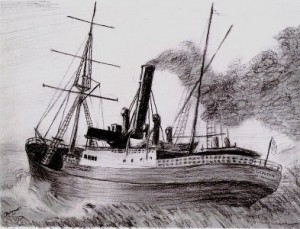 On the morning of April 18, the Georgette found the Catalpa, but in Captain Anthony's absence the First Mate refused to allow the colonial police to board as the ship was in international waters outside the colony's three mile limit. After steaming around, the Georgette was forced to go back into Fremantle for coal. The Fenians were finally brought safely on board the whaleboat narrowly avoiding capture by one of the police cutters. On shore the public mood sympathised with the escapees who were seen as "political" prisoners being punished for an offence against a government not society. The authorities, however, were determined to recapture the Irish rebels. The Georgette was coaled up and, with a small cannon on board, headed out to find the Catalpa.
On the morning of April 18, the Georgette found the Catalpa, but in Captain Anthony's absence the First Mate refused to allow the colonial police to board as the ship was in international waters outside the colony's three mile limit. After steaming around, the Georgette was forced to go back into Fremantle for coal. The Fenians were finally brought safely on board the whaleboat narrowly avoiding capture by one of the police cutters. On shore the public mood sympathised with the escapees who were seen as "political" prisoners being punished for an offence against a government not society. The authorities, however, were determined to recapture the Irish rebels. The Georgette was coaled up and, with a small cannon on board, headed out to find the Catalpa.
Bark Catalpa 1876;
Charles S Raleigh 1830-1925 oil on canvas
Fremantle Prison Escape Stories:
http://www.fremantleprison.com.au
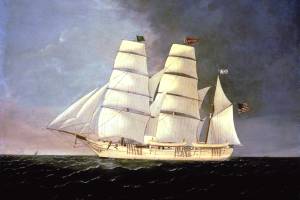 On the morning of 19 April 1876 there occurred off Fremantle one of the most dramatic events in Australia's colonial maritime history. At first light the Catalpa was sighted by her pursuers who soon drew alongside. On the whaler the Fenian escapees had armed themselves and were determined not to be recaptured. With Breslin hiding behind the gunwale, Captain Anthony faced off the challenges and threats from the Georgette to heave too and prepare to be boarded. When threatened that his masts would be blown in, and under Breslin's prompting, the Yankee skipper pointed to the American flag flying behind the ship: "That's the American flag; I am on the high seas; my flag protects me; if you fire on this ship you fire on the American flag".
On the morning of 19 April 1876 there occurred off Fremantle one of the most dramatic events in Australia's colonial maritime history. At first light the Catalpa was sighted by her pursuers who soon drew alongside. On the whaler the Fenian escapees had armed themselves and were determined not to be recaptured. With Breslin hiding behind the gunwale, Captain Anthony faced off the challenges and threats from the Georgette to heave too and prepare to be boarded. When threatened that his masts would be blown in, and under Breslin's prompting, the Yankee skipper pointed to the American flag flying behind the ship: "That's the American flag; I am on the high seas; my flag protects me; if you fire on this ship you fire on the American flag".
In reality, the colonial police were under orders from Governor Robinson not to create an incident outside territorial waters and, after steaming around threateningly for about an hour, the Georgette headed back to Fremantle.
The Catalpa sailed to New York where the local Irish community gave the six Fenians a tumultuous welcome.
Sources
The Fenians in Australia, Keith Amos, 1988 and Philip Fennell, Rootsweb, July 2007.
Australian Convict Transportation Registers “ Other Fleets & Ships, 1791-1868 (ancestry.com).
Irish Newspaper Articles (available online through the State Library of Western Australia).
UK, Military Campaign Medal and Award Rolls, 1793-1949 (ancestry.com).
Prison Commission Registers for Chatham Prison, Prisoners 9032 to 9041, National Archives Kew, (courtesy Bevan Carter).
Convicts in Western Australia 1850-1887, Rica Erickson & Gillian O'Mara.
The Catalpa Rescue 1876, Richard Reid, Senior Curator, National Museum of Australia.

